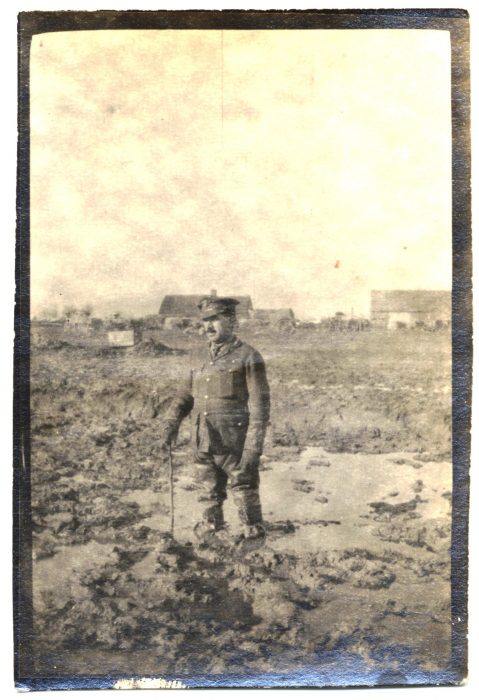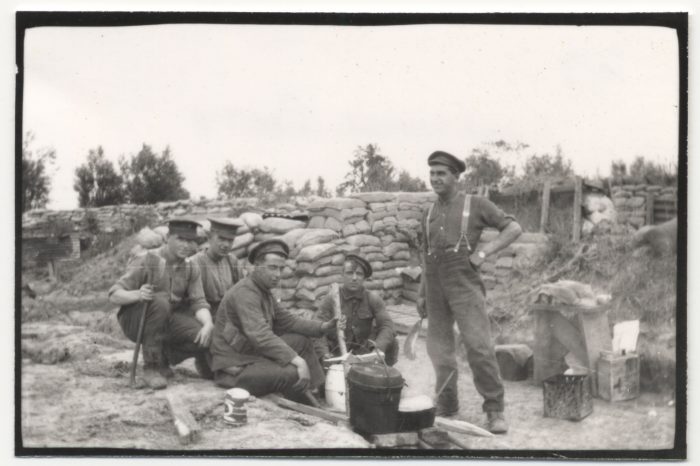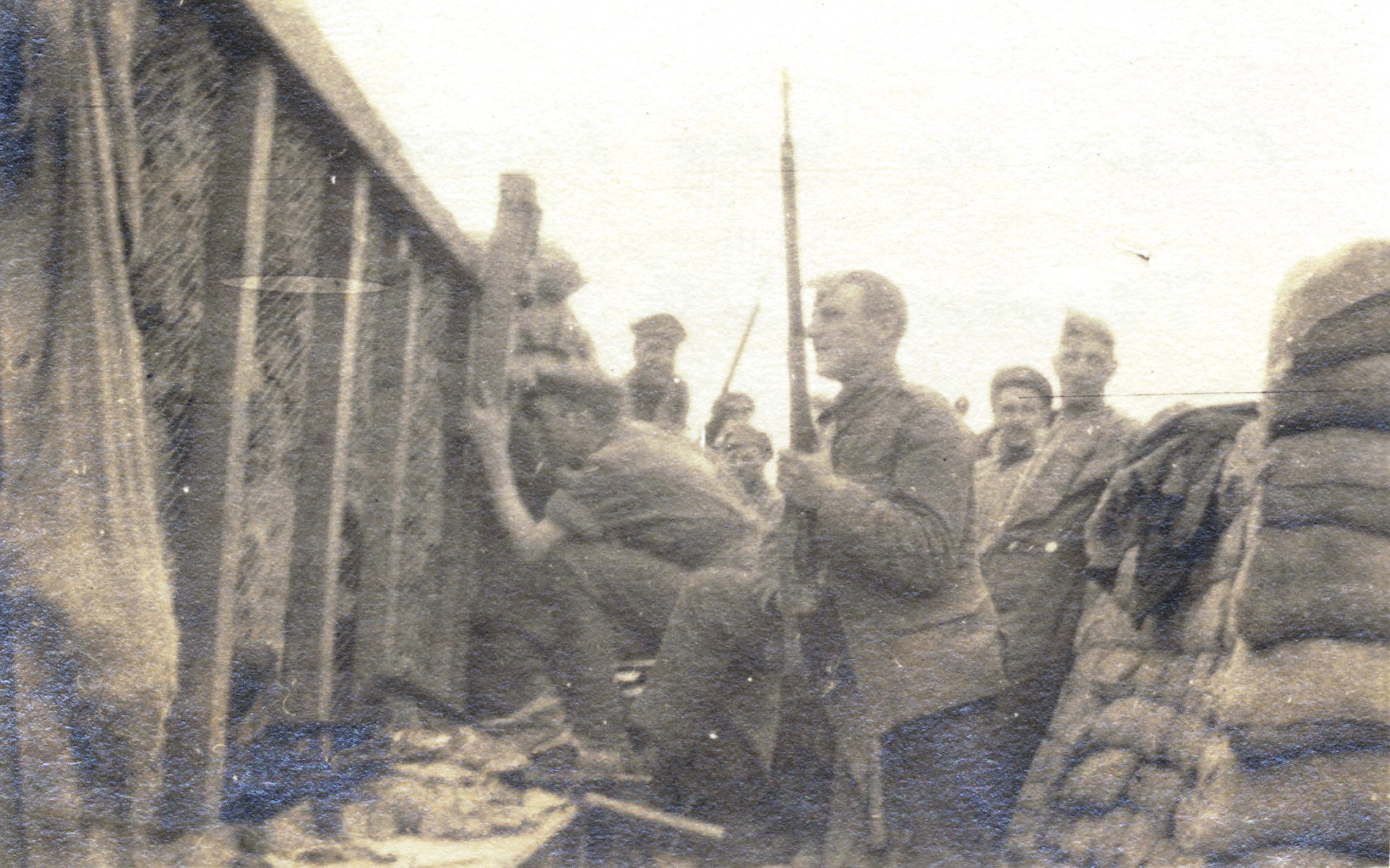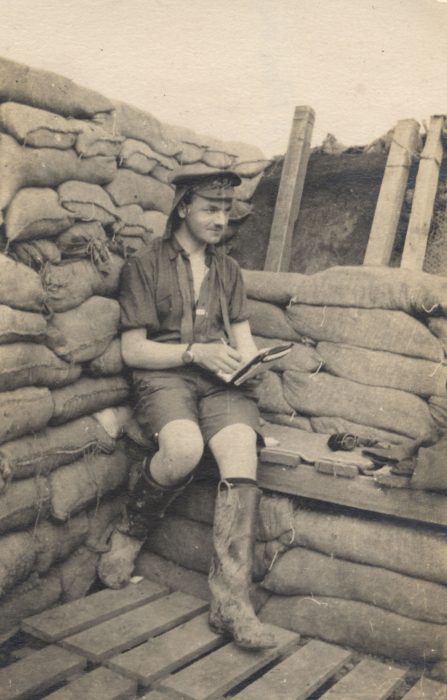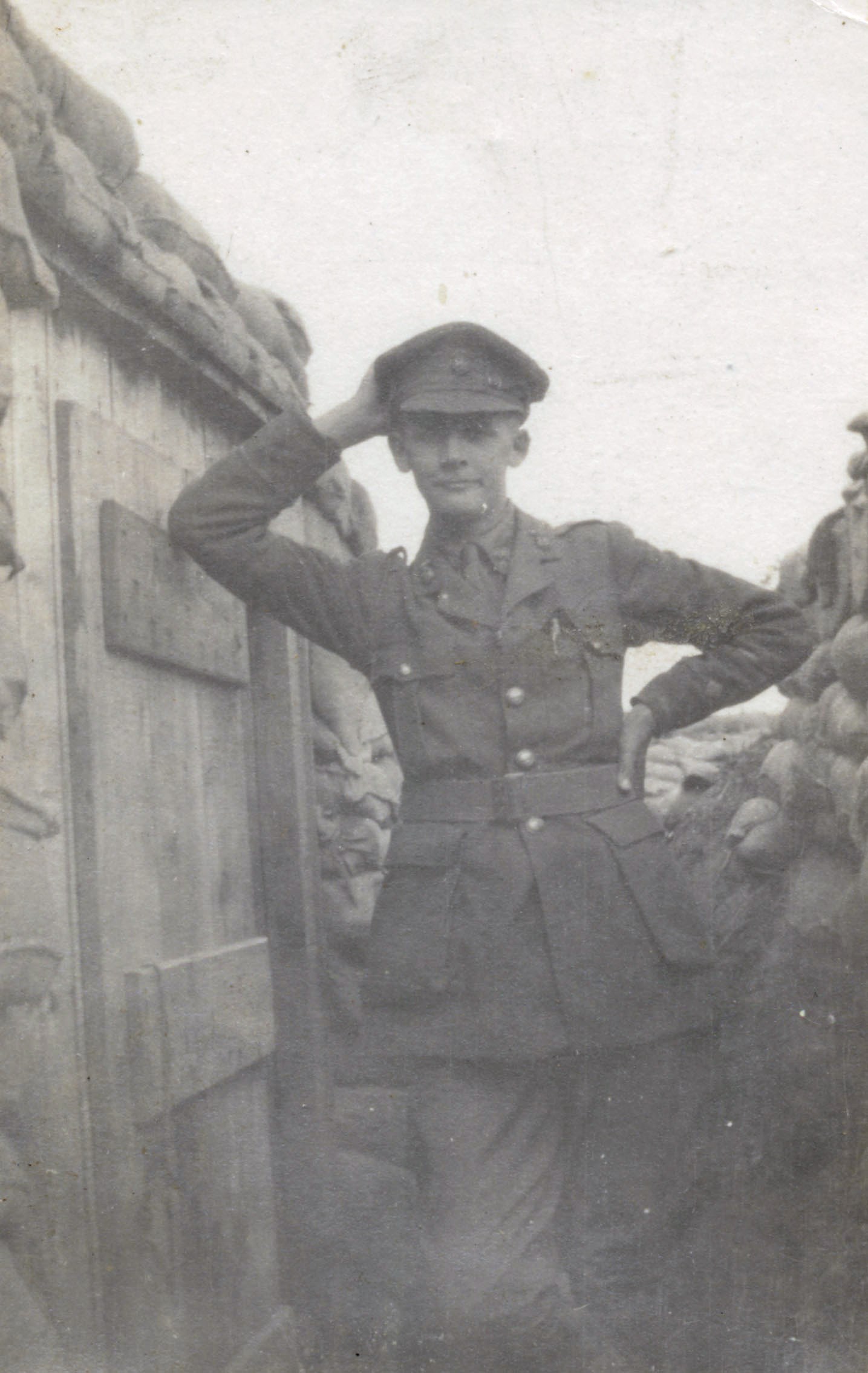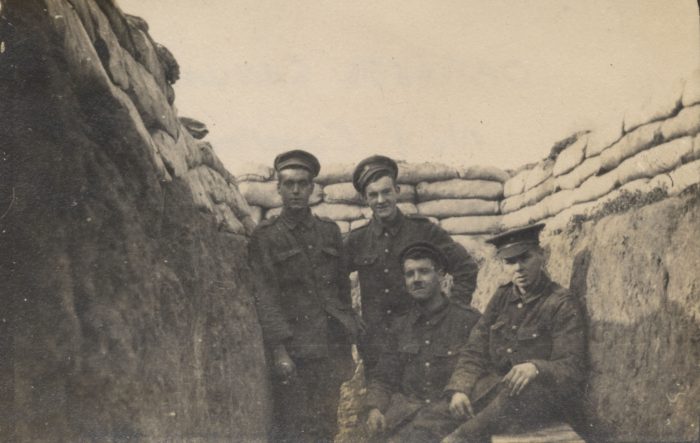Photograph of Northumberland Fusiliers in the trenches, 1915
Reference: NRO 06038/16, 29, 51, 58, 59, 65, 77
Suggested age groups: KS1, KS2, KS3, KS4, Lifelong Learners
Subject areas: History, Literacy, Geography
CONTEXT
The Royal Northumberland Fusiliers was an infantry regiment of the British Army. Traditionally, infantry soldiers fought on foot, in contrast to cavalry, who fought on horses.
During the First World War, the Northumberland Fusiliers raised or created 52 battalions. A battalion is a sub-group within a regiment which usually contains 300-1000 soldiers.
As the name suggest, the Northumberland Fusilisers were the local regiment and many men from Northumberland joined the Fusiliers (although that wasn’t always the case!).
This collection of images documents their everyday lives in the trenches during the First World War. Although soldiers were not really allowed to take cameras into the trenches, many did. The advances in photographic technology meant that cameras were smaller than they had ever been before. In 1897 Kodak produced the Folding Pocket Kodak; a camera that could (as the name suggests) fit in the pocket. In 1901 the Box Brownie was first sold by Kodak. The Box Brownie was a very simple camera that could be bought cheaply and marked the beginning of photography for the masses.
More photographs from this collection can be seen on the Northumberland Archives Flickr stream (please see below).
This shows an officer with the Northumberland Fusiliers standing up to his knees in mud. The environmental conditions in Northern France and Belgium often made living in the trenches difficult and hampered the fighting.
Captain Neville was killed in 1917. Information about his death and memorial can be found here:
https://www.cwgc.org/find-records/find-war-dead/casualty-details/157294/R%20P%20NEVILLE/
This photograph has obviously been set up for the camera, but construction and repair of trenches probably took up a lot of their time. It looks as if these soldiers might be standing by a dug-out (curtain to the left of the picture) and the materials used to construct the trench (sandbags, wood) can clearly be seen.
It seems likely that these men were not near the front as they are standing up straight and could probably be seen over the top of the trench.
A label on the back of this photograph reads: ‘Cookhouse party. Trench 74, second support, 20 Aug. 1915’. Support trenches were behind (and often parallel to) font-line trenches. They were connected by communication trenches that ran at right-angles to the support and front-line trenches (see Long Long Trail website for a diagram.)
Soldiers would spend time in the support trenches before being moved into the front line and then would be given periods of rest and training away from the trenches. Soldiers did not spend more than a few weeks at a time living the trenches.
The materials used to construct the trench can clearly been seen here (wire mesh in the wall of the front, sand bags, wood). The “fire step” can also be seen. For more on the construction of trenches see Long Long Trail website (link below) and Andy Robertshaw video (link below).
The soldier in the centre of the photograph is holding a rifle with bayonet attached. The soldier to the left is using a periscope to see over the top of the trench. See Empire Faith War link below for template and instructions for making a periscope.
Each battalion was divided into “companies” of about 50 men, under the command of a lieutenant.
The sandbags and duckboards under Cowen’s feet can be seen clearly in this photograph. He is wearing wellington boots. It is likely that he is writing notes for a report (but it could be suggested that he’s writing a poem!)
The dug-out in this photograph was most probably the regimental aid post where injured men could go for first aid. The structure is made of sandbags and has a material cover (tarpaulin) that could be pulled down over the door opening.
The man in the right of the picture is wearing an armband with the initials “SB”. This shows that he was a stretcher bearer. Each battalion had a number of stretcher bearers who would carry the injured. Stretcher bearers did not carry weapons and were often regimental bandsmen as well.
See Medicine in the Trenches section of online resources.
ACTIVITIES
ACTIVITY 1
Background
Support trenches were behind (and often parallel to) font-line trenches. They were connected by communication trenches that ran at right-angles to the support and front-line trenches. Soldiers would spend time in the support trenches before being moved into the front line and then would be given periods of rest and training away from the trenches. Soldiers did not spend more than a few weeks at a time living the trenches. Construction and repair of trenches probably took up a lot of their time.
SEE
See: What was used to construct the trenches?
See: How long did soldiers spend in the trenches?
See: What are the support trenches?
See: What is the front-line?
See: Where were the communication trenches?
THINK
Think: Why were trenches used during WW1?
Think: What are dugouts?
Think: What is no man’s land?
Think: What were conditions like in the trenches?
DO
Do: What can you tell about the trenches from these photographs? Write a list of words to describe what you can see.
Do: Create a map showing where the trench lines were in Europe during WW1.
Do: Draw a diagram of the trench system, showing the front-line trenches, support trenches and communication trenches.
Do: Using the testimonies from the Imperial War Museum website, make a list of what the soldiers did in the trenches.
Do: Using the testimonies from the Imperial War Museum website, make a list of the conditions that the soldiers describe in trenches.
Do: Using the testimonies from the Imperial War Museum website, make a list of the soldiers’ feelings towards the trenches.
Do: Use your lists to write a letter home from the perspective of a soldier focusing on what they did in the trenches; how they felt about the trenches; and what the conditions were like in the trenches.
Resources
ACTIVITY 2
Background
This collection of images documents their everyday lives in the trenches during the First World War. Although soldiers were not really allowed to take cameras into the trenches, many did. The advances in photographic technology meant that cameras were smaller than they had ever been before. In 1897 Kodak produced the Folding Pocket Kodak; a camera that could (as the name suggests) fit in the pocket. In 1901 the Box Brownie was first sold by Kodak. The Box Brownie was a very simple camera that could be bought cheaply and marked the beginning of photography for the masses.
SEE
See: What does this collection of images show?
See: Where were photographs taken?
See: Who is shown in the photographs?
See: Are these photographs posed or are they candid?
See: What types of environmental conditions do the photographs show?
See: What types of camera were available during this time?
THINK
Think: What is the purpose of documentary photographs?
Think: Why might soldiers have taken cameras with them to the trenches?
Think: Is it important to take photographs of war?
Think: What can we learn about the war by looking at photographs taken by soldiers?
Think: What is war photography?
Think: What is the role of a war photographer (photojournalist)?
Think: Is there a difference between photographs taken by soldiers and photographs taken by a war photographer?
Think: Why are some of these photographs different colours?
Think: How were photographs developed?
DO
Do: Look at the images of the soldiers in the trenches. What can you learn about them and the environment by looking at the photographs?
Do: Take some documentary photographs of the area around you. What could someone learn from looking at the photographs?
Do: Write down what you think are the similarities and difference between a soldier taking photographs in a war zone and a war photographer/photojournalist taking photographs in a war zone.
Do: Script a conversation between a soldier and a war photographer discussing their experiences while taking photographs in a war zone.
Do: Read Carol Ann Duffy’s poem ‘War Photographer’. Write a poem in response to Duffy’s from the perspective of a soldier looking back at photographs he has taken in the trenches.
Resources
OTHER ONLINE RESOURCES
Life in the Trenches
The Long Long Trail website, page for life in the trenches: https://www.longlongtrail.co.uk/soldiers/a-soldiers-life-1914-1918/life-in-the-trenches-of-the-first-world-war/
Youtube website, page for tour of a trench reconstruction with Andy Robertshaw: https://www.youtube.com/watch?v=lgRm7aU-GoI
Youtube website, aerial photography of a trench reconstruction: https://www.youtube.com/watch?v=hAJfRrkq_nk
Imperial War Museum website, page for oral history podcast about like in the trenches: https://www.iwm.org.uk/history/voices-of-the-first-world-war-trench-life
Empire Faith War website, page on how to make a trench periscope: http://www.empirefaithwar.com/learning-resources/education-zone/kids-activities/trench-periscope
Photography
Imperial War Museum website, page on photos of trench life: https://www.iwm.org.uk/history/10-photos-of-life-in-the-trenches
1914-1918 Online website, page on photography during WW1: https://encyclopedia.1914-1918-online.net/article/photography
Fickr website, page for Northumberland Archive’s photographs of Northumberland Fusiliers in the trenches: https://www.flickr.com/photos/99322319@N07/albums/72157644942508746/with/14337527755/
Medicine in the Trenches
Poetry by Heart website, page for “The Stretcher Bearer” poem: https://www.poetrybyheart.org.uk/poems/the-stretcher-bearer/
Durham at War website, page for photograph of stretcher bearers: https://www.durhamatwar.org.uk/material/637/
Vimeo website, page for Operation Ouch Goes Back in Time: https://vimeo.com/206582002
YouTube website, page for IWM clip of Dressing Station from film The Battle of the Somme: https://www.youtube.com/watch?v=xsz0-8-qAi8


